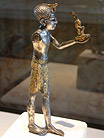The King as Provider of Justice
In both ancient Mesopotamia and Egypt, one of the most important roles of the king was to uphold justice and protect the weak in society. In ancient Mesopotamia, the weakest people were widows and children. In inscriptions, the kings often boasted of protecting widows and children, but there were also specific laws that prescribed how they were to be treated in certain cases. Often these revolved around inheritance issues, making sure a widow and her children were not left penniless after a husband’s and father’s death. In Egypt as well, it was the responsibility of the king to protect all of his people, whether rich or poor. The king was bound to the cosmic principal of ma’at, which represented truth, justice, and order in the universe.
In Mesopotamia the picture of the ruler as a shepherd, guiding and protecting his people—"the black-headed ones"—was a very ancient one. Artwork from fourth-millennium BCE Uruk depicts the ruler as a shepherd tending his flock. Egyptian kings also referred to themselves as shepherds. While the king acted as the provider of laws for his people, he did not usually decide cases. In Mesopotamia there was a complex legal system with judges who decided cases based on evidence provided by witnesses. We know this because there are thousands of legal texts in the form of clay tablets which contain the proceedings of legal cases. These deal with many kinds of legal issues including, among other things, lawsuits about inheritances, divorce, real estate, stolen goods, and adoption. In Egypt, there was no actual legal profession. Judicial tribunals could consist of members of the royal administration or ordinary people. Capital crimes were judged by the king and his vizier (akin to a prime minister).

 Jennie Myers
Jennie Myers
Research Associate, University of Chicago
Guiding Questions
1. How did the role of the ruler change in Mesopotamia?
2. In what ways were the roles of Egyptian and Mesopotamian rulers similar? What made them distinct?
3. What are some similarities between the justice systems of Egypt and Mesopotamia, and that of the United States?


 Print Page
Print Page

